What is BigCommerce?
BigCommerce is a paid-for, ‘hosted’ ecommerce solution that allows business owners to set up an online store and sell their products on the web.
‘Hosted’ means that BigCommerce runs on its own servers — so you don’t have to buy web hosting or install anything on your computer to use it. As long as you have access to a web browser and the internet, you can build and manage your store from anywhere.
BigCommerce is a ‘software as a service’ (SaaS) product, which means that you don’t own the software — instead, you pay a monthly fee to use it.
The product comes with a range of customizable templates to help you design your online store; you can use it to sell either physical or digital goods; and there are also some tools provided to help you market your store.

The platform is mainly aimed at people without much in the way of web design skills — but it also allows more tech-savvy users and developers to take things further by tweaking the HTML and CSS of BigCommerce stores.
As with all hosted online store and website building services — Shopify, Wix, Squarespace, Jimdo etc. — if BigCommerce were to shut down or change its feature set radically, you might find yourself in a position where you needed to migrate your store to another platform (Magento Go users can tell you all about that!).
But unless you are in a position to develop your own online store from scratch, you are in all likelihood going to end up using a hosted solution like BigCommerce anyway to run your store, and the good news is that it is one of the more established products of its kind out there.
According to BigCommerce, the company has 60,000 customers; 1,000+ employees, and a client roster that includes Ben and Jerry’s, Skull Candy and Paypal.
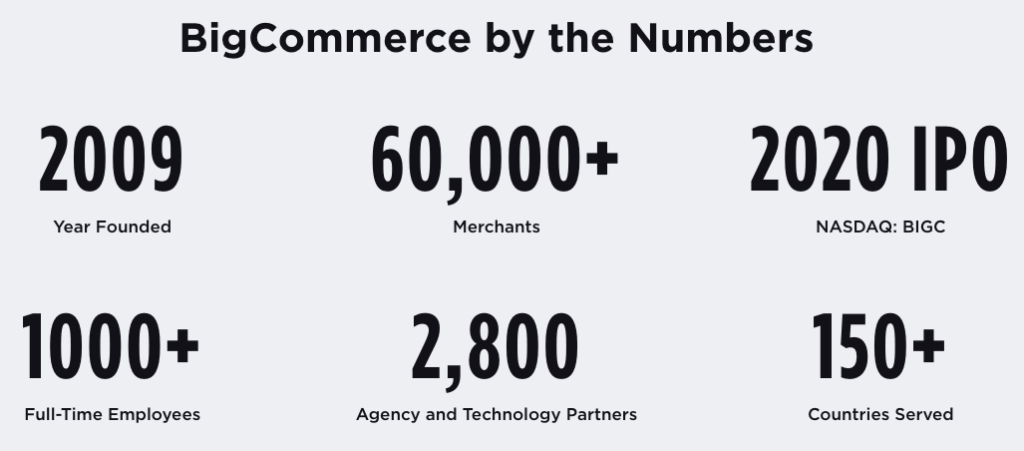
BigCommerce pricing
BigCommerce offers four monthly pricing plans, which are as follows:
- BigCommerce Standard: $29.95 per month
BigCommerce Plus: $79.95 per month
BigCommerce Pro: $299.95 per month
BigCommerce Enterprise: pricing varies, depending on your business requirements
A 10% discount is available for the ‘Plus’ and ‘Pro’ plans if you pay annually for them; and a 15-day free trial is also available — you can avail of this offer via this link.
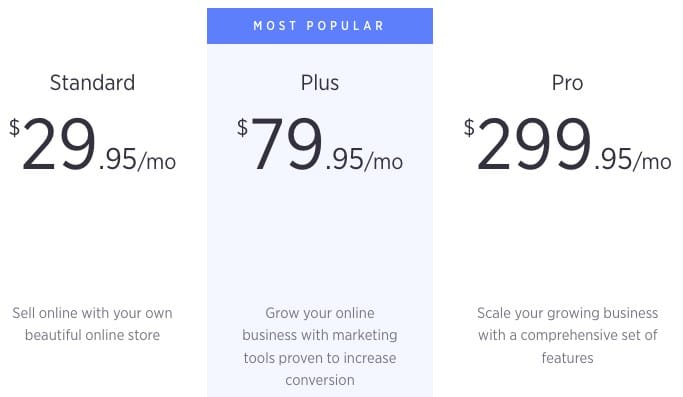
The ‘standard’, ‘plus’ and ‘pro’ plans are aimed at individuals and small businesses, and are part of the company’s “Essentials” range of products.
The Enterprise plan is geared more towards larger businesses and corporations (users with very high bandwidth and advanced selling requirements).
Core selling features
As we’ll see below, the exact features you get with BigCommerce depend very much on the plan you opt for, but important features common to all plans include:
the choice of 12 free templates
the ability to sell an unlimited number of physical or digital goods, in categories of your choosing and using shipping rates of your choosing
a drag-and-drop page builder
integrations with Paypal and a wide range of other payment gateways
unlimited staff accounts
blogging functionality
search engine optimisation (SEO) features
integration with various third-party apps
discount coupons and gift vouchers
product review functionality
the ability to tweak CSS and HTML
professional reporting
(You’ll learn more about the quality of all of these as you progress through this BigCommerce review).
This comprehensive set of features is fairly unique when it comes to online store builders — a lot of similar online store builders require you to upgrade to more expensive plans or install paid-for apps to access several of the above features.
This means that BigCommerce arguably offers considerably more bang for the buck than many competing products at its entry level monthly plan price point ($29.95 per month).
That said, you can unlock additional functionality in BigCommerce by paying more. So let’s drill down into the key differences between each BigCommerce plan.
Differences between the BigCommerce plans
As you’d expect, how much functionality you get from BigCommerce depends on how much you’re prepared to pay for it.
Each plan offers a distinct set of features, which I’ll go through now.
Bigcommerce Standard
BigCommerce’s cheapest offering, the ‘standard’ plan, costs $29.95, which is roughly the same price as Shopify, Volusion, Wix and Squarespace’s entry level ecommerce plans.
That said it is, in general, a much more comprehensive starter plan than any of these, providing:
- a standalone online store
- the ability to sell an unlimited number of products
- unlimited bandwidth and storage
- unlimited staff accounts
- real-time shipping quotations
- gift cards and discount codes
- ratings and reviews functionality
- multi-currency selling
- point of sale (POS) functionality (this lets you use a BigCommerce store to sell in a physical location)
- professional reporting
- AMP (accelerated mobile pages) functionality
As discussed above, this represents a lot of ecommerce bang for your buck — pretty much all the key ingredients of an online store are provided on BigCommerce’s standard plan; this is not always the case with entry-level plans from other competing products.
Significantly, the BigCommerce Standard plan facilitates selling in multiple currencies, with automatic conversion available — again, this is fairly unique.
The main criticism you could make regarding the entry level BigCommerce plan is that abandoned cart saving features are not included with it.
An abandoned cart saver is an important piece of functionality, because you can use it to identify people who have stopped their purchase mid-way through, and automatically send them a reminder email encouraging them to complete the purchase.
The similarly-priced Shopify ‘Basic’ plan includes this, and it’s also available at a cheaper price point from Squarespace, so BigCommerce falls down a bit by comparison here.
There is an annual sales limit for BigCommerce Standard of $50,000.
BigCommerce Plus
Next we have the ‘BigCommerce Plus’ plan.
In addition to the core functionality as you’ll find on the standard plan, it provides
- an abandoned cart saver tool
- a ‘persistent cart’ (this saves products to a customer’s cart irrespective of device used)
- stored credit cards (this allows your regular customers to save their card details on your store)
- customer grouping / segmentation.
With regard to the last feature mentioned above, customer grouping, this lets you divide customers into different segments, so that you can reward different customers based on activity and particular purchases. You could, for example, use this functionality to create a loyalty programme.
The annual sales limit for BigCommerce Plus is $180,000.
BigCommerce Pro
The next plan up in the mix is ‘BigCommerce Pro’. With this plan, you don’t get a huge amount of extra functionality over BigCommerce Plus — but you do get a significantly increased sales limit.
This permits up to $400,000 in online sales, with an additional fee of $150 per month per $200k in sales.
One extra feature which is worth drawing attention to on this plan is Google Customer Reviews — a programme that lets you collect and display feedback from users who’ve made a purchase from your online store.
If you’ve enabled Google Customer Reviews, once a customer buys a product from your BigCommerce store, they will be asked if they’d like to review it on Google (after it’s been delivered).
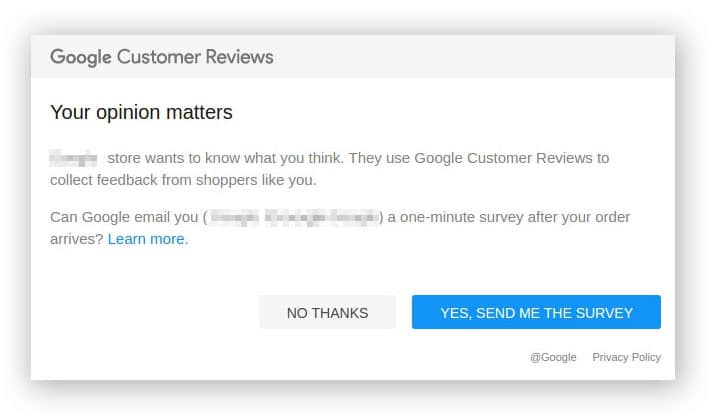
If the customer indicates that they want to do this, Google will email them a survey after their order has arrived. The collected ratings are then displayed on your site (via an optional Google Customer Reviews badge), on Search Ads, and in Google Shopping.
The other main features that you gain on this plan are advanced product filtering and custom SSL via a third party.
BigCommerce Enterprise
Finally, there’s BigCommerce’s “Enterprise” plan to consider.
As this plan name suggests, it is geared towards corporate users that have very high volumes of sales (typically, over $1,000,000), and, accordingly, advanced selling requirements.
Features that are included on ‘Enterprise’ but not on the cheaper plans include:
price lists (this allows you to create pricing rules based on customer groups — so different groups of customers see different product prices based on how you’ve segmented them)
unlimited API calls (BigCommerce’s API — ‘Application Programming Interface’ — allows developers to share data between your store and other apps, and the Enterprise plan doesn’t place any limits on how many times these ‘data sharing’ connections can be made. This makes it better suited to businesses that are expecting a high volume of traffic / API connections to their store)
- priority support (including API support)
BigCommerce consulting / account management
.
If you’re interested in the Enterprise plan you will need to discuss your requirements with BigCommerce to establish pricing — the costs will reflect your business needs, but BigCommerce claims that they are cheaper than those for Shopify’s enterprise grade plan (this is called ‘Shopify Plus’ and typically comes in at around $2,000 per month).
You can generally expect a lot more support from BigCommerce if you purchase an Enterprise plan — in-depth support with data migration, setup, account management can all be facilitated.
The annuals sales limit for BigCommerce Enterprise is negotiable.
Now, let’s drill down into sales limits in a bit more depth.
Transaction fees and sales limits
A question which many potential BigCommerce users ask is: “how much of a cut of my sales are they going to take?”
Well, the good news is that there are no transaction fees on any BigCommerce plan. This is in marked contrast to its key competitors.
However, you do have to pay credit card processing fees to the company you select to process payments. These will depend on the payment gateway you use (more on that in a moment).
The bad news, and as mentioned above, is that BigCommerce places a limits on your annual online sales.
These limits are as follows:
BigCommerce Standard: $50,000
BigCommerce Plus: $180,000
BigCommerce Pro: $400,000
BigCommerce Enterprise: negotiable.
(If you’re on the ‘BigCommerce Pro’ plan, you can increase the sales limit by paying $150 per month for every additional $200k in sales).
I contacted BigCommerce to see what happens if you breach these limits and the response was:
“There is an additional 1,000-2,000 order limit per plan that users are able to go over before being forced to upgrade. During this time users will receive notifications about upgrading their plan as they are over the limit. But we will not prevent additional orders from coming through until they exceed the additional 1,000-2,000 overage order provided.”
BigCommerce
I expect the limits issue won’t be a showstopper for most merchants — if your store is bringing in $400,000 a year you probably won’t be moaning too much about having to pay an extra $150 per month for breaching the limit…but for some merchants they will be a bit of an annoyance.
I have yet to come across these sorts of limits on competing products like Shopify or Squarespace, so it’s a bit of a ‘could do better’ here for BigCommerce.
Payment gateways
There are two ways to accept credit card payments in BigCommerce.
The simplest thing to do is to use the default payment option for BigCommerce, Paypal powered by Braintree. Doing so makes for an easy payment gateway setup and gives you preferential Paypal rates for credit card transactions (which decrease as you go up BigCommerce’s pricing ladder).
The US rates are currently as follows:
BigCommerce Standard: 2.59% + 49c
BigCommerce Plus: 2.35% + 49c
BigCommerce Pro: 2.05% + 30c
BigCommerce Enterprise: 2.05% + 30c
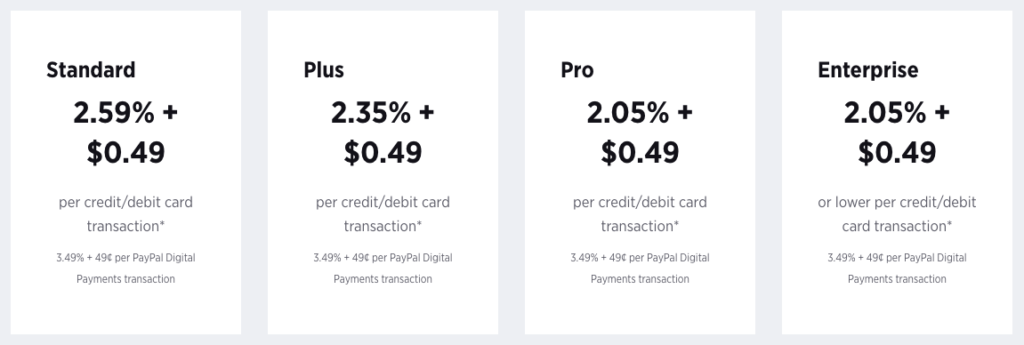
These fees can be lower in other countries — for example, in the UK, you’re looking at rates of 1.55% to 1.85%, depending on plan.
There’s also the option of using a third-party payment processor for your online store: these are called ‘payment gateways,’ and around 45 are available for BigCommerce, depending on your country of operation.
Depending on the payment gateway provider you choose, you can expect to pay a monthly fee, a transaction fee, or both.
It’s important to note that these fees are not applied by BigCommerce but by the payment gateway provider in question.
(This contrasts positively with Shopify, which charges you transaction fees to use a third-party payment gateway).
Integrating a payment gateway with a hosted ecommerce solution like BigCommerce can occasionally be bit of a lengthy process, which involves setting up ‘merchant accounts’ with your chosen gateway provider and configuring them so that they work with your store.
It is still worth looking at the various fees involved with other payment gateway providers though — depending on what you sell and how much of it, using a different payment gateway may still be the best route for you to go down, even if it involves a bit more configuration time.
BigCommerce templates
BigCommerce offers a reasonably good selection of responsive templates that you can use for the design of your online store.
There are 12 free BigCommerce themes and around 165 paid themes; each theme contains a number of different variants, so there quite is a lot to choose from.

Free themes
The free themes on offer are contemporary, professional in appearance and provide a good starting point for building an online store.
However, a few of them are very similar to each other, with the main differences simply involving colour scheme. This is a particular issue with the free themes — although there are technically 12 available, it feels more like there are actually just five themes to choose from.
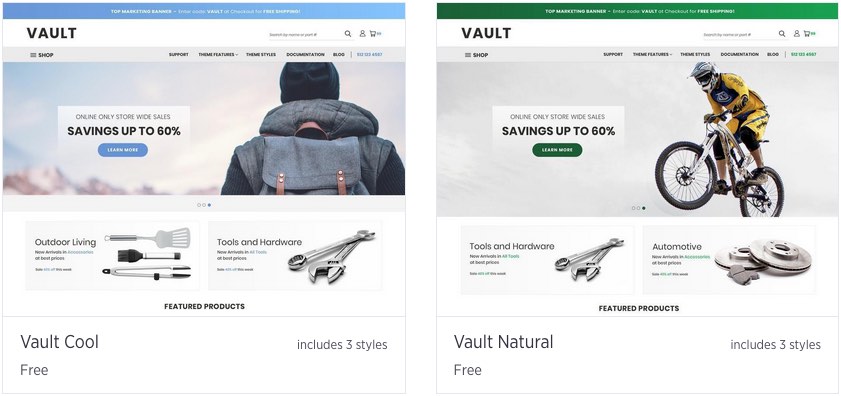
Paid-for themes
To extend your options here, you can consider purchasing one of the paid-for BigCommerce themes. These are fairly reasonably priced, starting out at $150 and going up to $300 (occasionally you can pick one up at a discounted rate — I’ve seen premium themes available for $99 when on sale).

Again, you’ll find that some of these are a bit too similar to each other to merit being classified as different themes, however.
Overall, you will be able to create a professional design for your BigCommerce store using either the free or premium themes — it’d just be good to see the range of themes extended a bit.
Using the themes
One area where there could be an improvement made to the themes involves typefaces: the bundled font selection in most of the free themes is small by comparison to those offered by competitors like Shopify and Squarespace (in some cases limiting you to just 3 or 4 fonts).
Although adding another font is perfectly doable, it involves adding some code to your template file, which won’t appeal to all users.
It’s also a bit hard to hide certain site elements in BigCommerce templates — for example, when testing the ‘Vault’ theme for this BigCommerce review, I couldn’t find an obvious way to remove the search bar; in the ‘Fortune’ theme, I couldn’t hide the sidebar without resorting to adding some CSS.
On the plus side, all the free themes are fully responsive, meaning they’ll automatically display correctly on any device (mobile, tablet, desktop etc.); and significantly, they are AMP-enabled too (I discuss AMP — Accelerated Mobile Pages format — later on in this review).
Product options, variants and categories
A particularly strong feature of BigCommerce is the way it handles product options and variants.
Unlike its rival Shopify, which only allows you to present users with three product options without resorting to coding or paying for third-party apps, BigCommerce lets you create a large number of product options (up to 250 per product).
BigCommerce’s product variant limit is generous too — you can present a product in up to 600 variants.
(Product variants are the number of product option combinations you can offer — for example a small, blue t-shirt would count as one variant; a large, red one would count as another, and so on).
Again for perspective, Shopify and Squarespace’s equivalent limits are 100 and 250 respectively.
So if you are selling products that come in a lot of different formats, BigCommerce may be a particularly good option. See the below video for more detail on how it all works.
Although BigCommerce is great when it comes to product options, it’s less impressive when it comes to product categories — whilst creating and editing them is straightforward enough, you have to assign them to individual products in quite a manual fashion.
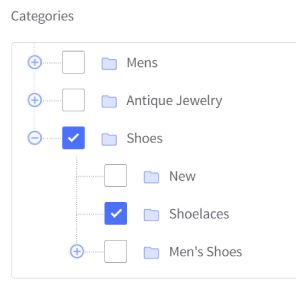
It would be better — as is the case with some other leading online store builders, notably Shopify — if you could automatically categorize products based on product name or tags.
BigCommerce’s abandoned cart saver feature
A BigCommerce feature worth singling out for praise is its abandoned cart feature – it’s arguably one of the best out there.
The tool allows you to create up to three automated emails to site visitors who go part of the way through the sales process only to leave your store without buying anything.
This has the potential to dramatically increase your revenue with little effort – other than the ‘one-off’ time investment in setting up the automated messages – being involved.
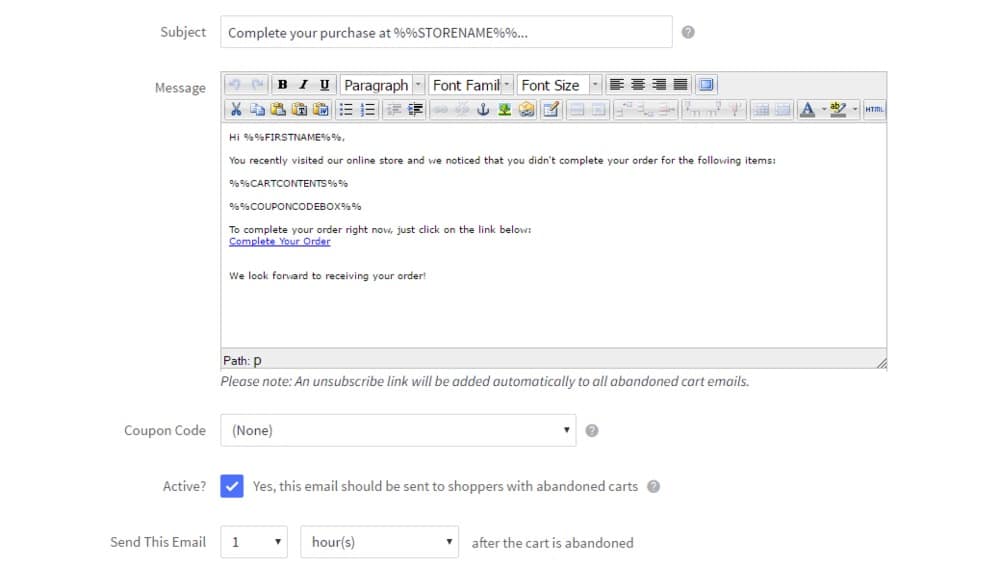
It’s important to note however that the abandoned cart saver functionality only comes with BigCommerce’s ‘Plus’, ‘Pro’ and ‘Enterprise’ plans. This makes obtaining this functionality a bit more expensive than from competing products.
That said, the BigCommerce abandoned cart saver is more flexible than the equivalent offerings from its key competitors — most of them limit the number of automated emails to one, whereas BigCommerce lets you send three follow-ups. So there may be some justification for the higher price.
In my experience, abandoned cart saver functionality usually pays for itself, and if you are confident of receiving a large number of visits to your site, purchasing a BigCommerce plan featuring the abandoned cart saver makes a lot of sense.
Selling in multiple currencies
You usually get more sales if you sell in the currency used by your site visitors.
So, if you’re selling in multiple countries, it’s a good idea to let your potential customers choose their own currency (or, better still, present products in your site visitors’ currency automatically).
The really good news is that with BigCommerce’s free themes, you get a very good multi-currency solution out of the box — one that facilitates automatic currency conversion based on IP address.
If you’re using a paid-for template, you may need to use a third-party app to facilitate multi-currency — Bold Multi-Currency is a good option.
But overall, BigCommerce scores highly when it comes to multi-currency selling — some competing solutions don’t offer this functionality at all (i.e., Squarespace) and others don’t provide fully automatic currency conversion unless you use an app or on an expensive enterprise-level plan (Shopify being a key example).
For me, this multi-currency functionality is one of the strongest arguments for choosing BigCommerce over a competing ecommerce solution.
A multi-channel approach to selling
As with other leading ecommerce platforms, BigCommerce doesn’t restrict you to selling on your own online store — you can sell your products on several sales channels.
‘Out of the box’ options on this front include Facebook, Amazon, Instagram and Ebay, with more available via third-party apps (available from the BigCommerce app store).
Selling in multiple languages with BigCommerce
BigCommerce doesn’t have any built-in multilingual capabilites; however, you can still sell in multiple languages using the platform, thanks to an integration with the translation app Weglot.
The BigCommerce + Weglot approach brings both advantages and disadvantages. On the plus side, you can offer your site in up to 100+ languages; and the translations are automatic (with the choice to manually edit them).
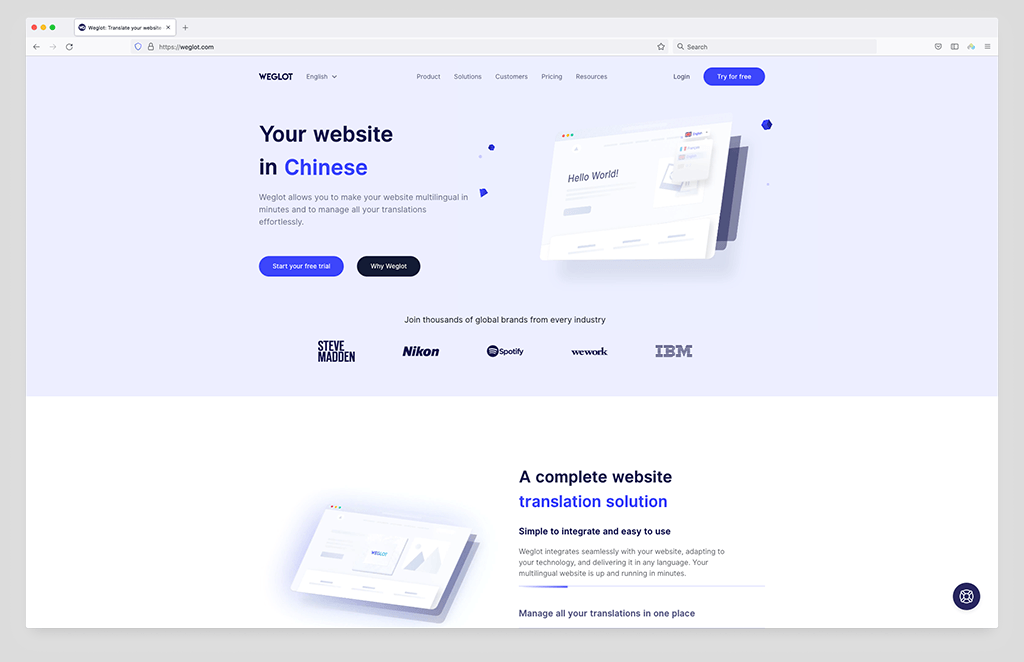
On the down side, you will need to pay extra for the Weglot app on top of your BigCommerce fees — between $11 and $230 depdning on needs. And, machine translations, whilst improving all the time, are not usually good as those provided by an experienced human translator.
Dropshipping with BigCommerce
Many potential BigCommerce merchants will be interested to learn how it handles dropshipping.
Dropshipping is a selling model where you don’t keep what you’re selling in stock. Instead, you take an order, send its details to a supplier, and they send the goods to your customer.
The advantage of this model is that you don’t need much start-up capital, as there’s no need to purchase any stock before you start selling.
(The disadvantage is that the low start-up costs mean that there a lot of people doing it, and it ends up being quite a competitive business area.)
You can use BigCommerce to dropship, but in order to do so, you’ll need to install a third-party app from BigCommerce’s app store (of which more in a moment) to facilitate it.
There are quite a few apps available to help you dropship with BigCommerce, with key ones including:
Ali-Express Dropshipping
Spocket
- Wholesale B2B
- Inventory Source
- Printful
These apps vary in price to use, with free trials being available for some of them.
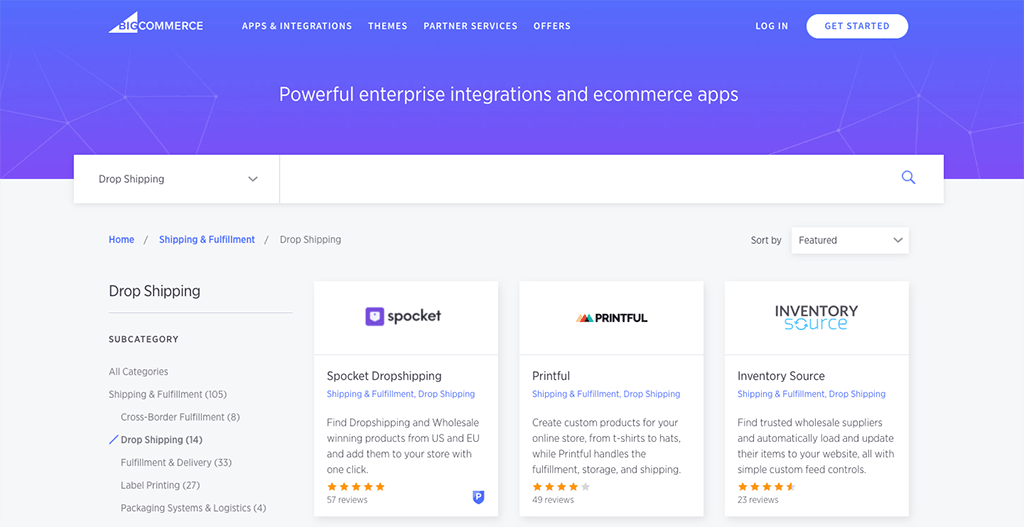
Point of sale functionality in BigCommerce
A nice feature of BigCommerce is that it doesn’t just let you run an online store — it can facilitate selling at ‘point of sale’ (POS) too.
Thanks to some integrations with various POS providers — including Square, Clover, Hike and Vend — you can take payment and sync inventory when selling from a physical location (such as a store, market stall, event etc.).

You’ll need to research each of the available providers carefully to ensure you find the right one for your needs, but it’s good that BigCommerce offers a few options on this front.
Other competing ecommerce solutions either don’t offer POS at all — or are more restrictive in terms of what countries they can be used in, or the hardware and software options that are available.
File uploads and custom fields
Merchants who need to capture text to complete an order — for example jewellers who need personalised text for an engraving, or printers who need their customers to supply a JPG of a logo for a t-shirt — will find BigCommerce’s approach to custom fields and file uploads particularly good.
Creating custom fields and capturing data using them is really straightforward in BigCommerce — you simply find the relevant product, create your custom field, name it and then your site users will be able to enter information into it at the point of purchase.
Similarly, it’s really easy to allow your users to upload a file — again, it’s just a case of editing your product so that it contains an ‘upload file.’ Your customers will then be able to upload a file — up to a generous 500MB in size — when they purchase that product.
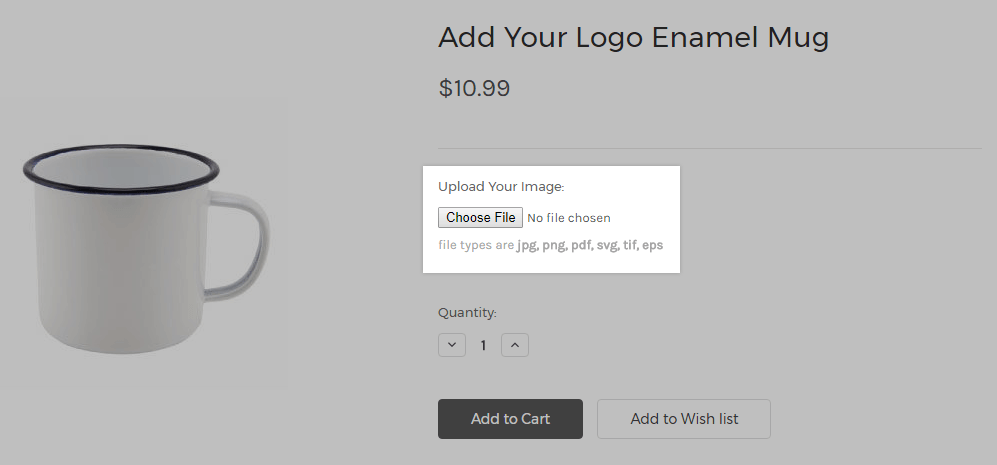
This functionality is implemented considerably better on BigCommerce than some competing products.
For example, while Shopify allows you to create custom fields and give users the option to upload files, it’s a fiddly process involving adding ‘line item properties’ to your code.
Squarespace allows you to create a custom field easily enough, but doesn’t facilitate file uploads.
So all in all, a thumbs-up for BigCommerce in this area.
Tax rules and VAT MOSS
US and Canada
One of the challenges of creating an online store is that you can end up selling goods in jurisdictions with differing tax rates — something that needs to be reflected in the pricing of your products. This is a particular headache for merchants based in the USA and Canada, where different states / provinces apply different tax rules.
Thankfully, BigCommerce allows you to apply tax rates automatically for these two countries, which is a huge time saver. You will however need to research and install a third-party app to facilitate this — Avalara, Vertex or Taxjar — so you can expect some additional costs.
(That said, Avalara can be used for free up until 2022, so long as you don’t exceed 5,000 tax calcluations).
European Union
If you intend to sell digital products to European Union consumers with BigCommerce, and expect to raise over €10,000 a year in revenue from doing so, you’ll need to familiarise yourself with something called VAT MOSS (this is short for ‘VAT Mini One Stop Shop’).
VAT MOSS requires you to apply country-specific rates of VAT to digital products — even if you are running a business that is based outside of the EU.
Unlike key competitor Shopify, BigCommerce doesn’t seem to provide an automatic way to do this — you will have to set up tax rates manually in order to facilitate it.
Shipping options
BigCommerce allows you to set up a variety of shipping rules / methods:
Free shipping rates
Flat rates
Price-based rates
Weight-based rates
In-store pickup
Real time shipping rates from third-party carriers
BigCommerce has an edge over other ecommerce platforms when it comes to third-party real time shipping rates — you can access this functionality on any of its plans, whereas with leading competitors you’ll usually need to be on one of the most expensive ones.
However, some competing products — notably Shopify and Etsy — allow you to avail of discounted shipping rates if you are based in certain countries and are happy to use their preferred providers. These sort of discounts are not yet available with BigCommerce.
Enhancing your BigCommerce store’s functionality via the app store
If the standard set of features provided by BigCommerce isn’t sufficient for your needs, then you might want to consider purchasing some apps from its app store — or to call it by its proper name, the ‘Ecommerce Apps Marketplace.’
A fairly wide range of integrations is available in the app store, which let you add many additional features to your BigCommerce store.
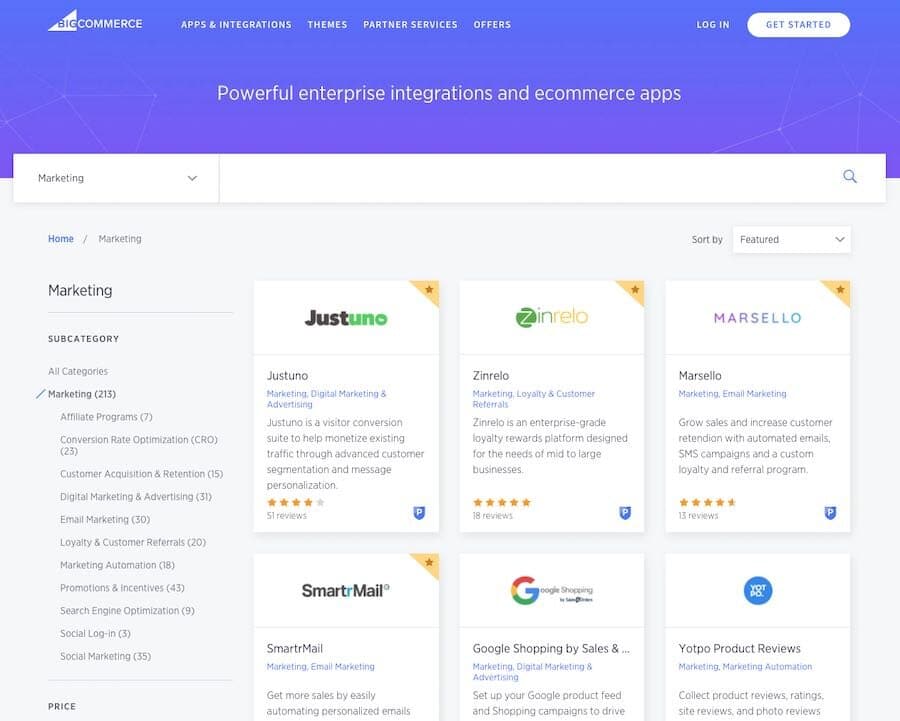
You can add apps that deal with lots of different aspects of of running an online business — categories include:
accounting
CRM
marketing
shipping
and so on.
Integrations are available for many well-known other business SaaS apps — for example, you’ll find apps for Mailchimp, Zendesk, Xero and Salesforce. There is often a cost associated with these apps, but on the plus side they do open up a world of advanced features for your online store.
In total, there are around 1,000 apps available for BigCommerce. This isn’t as many as rival Shopify provides (it offers over 6,000), but a key app which IS provided by BigCommerce but not by Shopify is an official integration for Mailchimp.
(Due to a dispute between Shopify and Mailchimp over data protection issues, an official integration between these two platforms is no longer available and you will need to use a workaround to make two platforms talk to each other.)
Interface and ease-of-use
BigCommerce’s interface is in general straightforward and user friendly; it’s relatively similar in quality and appearance to Shopify’s and Squarepace’s. It’s not entirely dissimilar to a WordPress dashboard either, and anyone familiar with a contemporary content management system (CMS) should find it pretty easy to use.
A vertical menu on the left hand side of the screen gives you easy access to the key features — and the labels (‘orders’, ‘storefront design’, ‘analytics’ etc.) make it obvious where you’ll find all the key features.
Once you’ve selected an option from the menu on the left, the associated content or data is displayed on the right — you can then edit or view accordingly.
An interesting recent addition to the BigCommerce feature set is a drag-and-drop page builder; this lets you select content blocks (text, columns, images etc.) and drop them into position on your pages as appropriate.
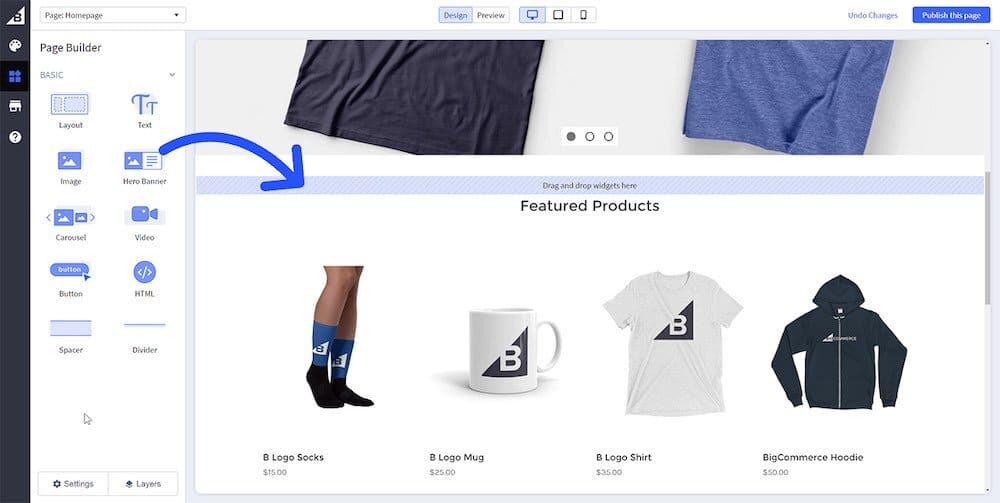
So in general, I’ve found BigCommerce easy to use and get started with — certainly when it comes to managing products and catalogues, it definitely stands up well in terms of usability by comparison to Shopify and Squarespace, and it beats Volusion hands down.
However, when it comes to managing content and layout, there is room for improvement.
This is chiefly because despite the welcome addition of the page builder, it’s not as easy to change the layout of a BigCommerce page as perhaps it should be — some elements are hard to remove or hide, and as mentioned above, changing fonts is not as easy as it should be (the default range provided with the free templates is fairly limited).
Additionally, whilst the page builder is a potentially useful new development, there is scope to implement it slightly better.
You can only access the page builder if you go to the theme customizer — if you navigate to the web page you want to edit in the BigCommerce back end, you arrive at a rather old-fashioned WYSIWYG (what-you-see-is-what-you-get) editor. This is a bit confusing.
The below video gives you a quick overview of the BigCommerce interface.
BigCommerce review: conclusion
Ultimately, BigCommerce is one of the most feature-packed hosted online store builders I’ve tested — in particular, its entry-level plan provides significantly more ‘bang for the buck’ than many competing products. It’s strong on the SEO front, with AMP functionality and automatic image optimisation features being provided out of the box. Its multi-currency selling functionality is really good too — and one the strongest arguments for using this product over a competing one.
The main thing that needs improvement in BigCommerce would probably be its template selection — I think the free options provided could be more varied, they’re not quite as editable as they should be, and it would be better if they give you access to a wider range of web fonts.
I hope this BigCommerce review has helped give you a sense of this product and whether it’s suitable for your needs — but as usual, it’s always best to try before you buy, and you can avail of a free BigCommerce trial here.
Finally, below you will find my summary of the key pros and cons of BigCommerce.
Our overall rating: 4.4/5
Key pros and cons of BigCommerce
Pros of BigCommerce
The overall feature set on entry-level BigCommerce plans is very comprehensive. Many advanced features that other platforms charge a premium for are available at a much lower cost with BigCommerce.
It makes selling in multiple currencies very straightforward.
Third party real time shipping calculations are available on any plan — this distinguishes BigCommerce from key competitors like Squarespace and Shopify, which require you to be on a premium plan or buy an add-on to avail of this functionality.
There are no transaction fees applied by BigCommerce, even if you use a third-party payment gateway.
You get a good set of reporting tools on all plans — again, this is not the case with all competing products.
It’s really easy to create custom fields.
Allowing your customers to upload files during their purchase is really easy.
It comes with built-in product review functionality.
It comes with drag-and-drop page builder functionality.
Its SEO features are great — you can create short URLs, AMP format is available on all its templates, and automatic image optimization is included on all plans.
The ‘abandoned cart saver’ tool is more comprehensive than the similar offering from competitors.
You get an unlimited number of staff accounts on any plan.
It comes with a built-in blog.
You can avail of cheaper-than-usual Paypal card transaction fees with BigCommerce, thanks to its preferential arrangement with Braintree.
It’s a very flexible solution for vendors with a lot of different product variants.
The built-in cookie consent feature helps you meet GDPR requirements in ways that other similar platforms don’t.
You can try the product free for 15 days
Cons of BigCommerce
By comparison to some of its competitors, you have to pay quite a lot to avail of abandoned cart functionality.
Limits are placed on annual online sales — and if you exceed them, you’ll need to upgrade to a more expensive monthly plan.
The free themes are in many cases too similar to each other.
The number of typefaces included in the free themes is very limited.
The page builder functionality needs quite a bit of improvement — based on my experience, it can be a bit buggy, and it’s confusingly implemented.
- Unlike some competing products, there’s no shipping discounts available on any plan.
It could be a bit easier to edit the free templates.
The built-in blog doesn’t facilitate RSS feeds.
VAT MOSS rates aren’t currently catered for.